Animation Asia Conference 2009 (AAC) is an industry event held in tandem with Anime Festival Asia this year, acting as a sort of pre-event for the commercial participants for AFA to share their experiences and exchange name cards.
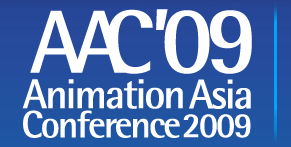
Having been to similar conferences in the IT industry, I didn’t have high hopes for this one. Often, it’s a bunch of really boring people in suits talking about how Asia is an emerging market and Singapore is poised to be a regional hub. AAC on the other hand turned out to be a rather pleasant surprise.
I stepped into the Suntec Convention Centre auditorium on Friday morning with great reservations. I was nearly half an hour late and the keynote address by Mr. Tsuguhiko Kadokawa, CEO of Kadokawa Group, was already coming to an end. I entered quietly through the back door, just as I did the numerous time I was late for lecture in school, and resigned myself to inevitable death by boredom which, no disrespect to Mr. Kadokawa, was only made more certain by the last few slides of his presentation.
The first speaker was Mamoru Hosoda, the director of Tokikake and Summer Wars. A prior glance through the list of speakers had given me the impression that he was going to be one of the few interesting speakers for the day. This rare spot of optimism was quickly overturned when it became apparent that instead of a personal presentation, the format was going to be a mock interview conducted by ANN’s Justin Sevakis.
I was puzzled by this arrangement because all it did was to add an additional layer of interpretations to the whole process as Justin was asking the questions in English… The interpretor was pretty bad and half the time Hosoda was answering different questions from the one asked. It wasn’t the engaging presentation I had hoped for.
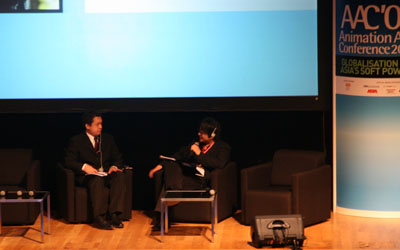
Justin Sevakis and Mamoru Hosoda on stage
Hosoda mentioned that Toki wo Kakeru Shoujo was made for Japanese high school students and he didn’t expect it to do so well overseas. His main sources of inspiration are Hayao Miyazaki and Disney and he sees Pokémon to be the first to show that anime do not need to be adapted for local tastes in order to succeed globally. I’m not so sure about that one…
Edmund Shern, CEO of local media company Storm Lion and the founder of the ever popular Imaginary Friends Studios, went on stage with a few guys from Production I.G. to talk about their latest collaboration, Titan Rain.
Given that Storm Lion was only incorporated last November, it’s pretty amazing that their comic series Freedom Formula has already been picked up by New Regency to be made into a live-action title distributed by 20th Century Fox. And considering the large number of collaboration requests from Hollywood studios that get rejected by Production I.G., Edmund must really know his stuff. Mitsuhisa Ishikawa, president of Production I.G., mentioned that he decided to do this with Storm Lion because it presented a creative vision as opposed to a profitable business proposal. Hollywood, take notes.
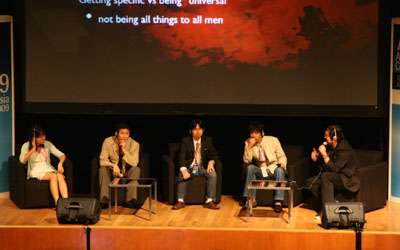
Edmund Shern and the Production I.G. guys
Of course, while it’s great that a Singapore media company has managed to find a place alongside the big industry players, I suspect this has more to do with Edmund’s personal experience than the local scene as a whole. Time will tell.
Mr. Phoon Chiong Kit, deputy chairman of Imagi International Holdings Limited, gave a talk about why he believed Astro Boy has failed rather badly in the box office. The title of his talk is “Distributing Animation Across Markets and Cultures” and frankly I thought it was going to be a real dozer, but I was proven wrong. It was actually pretty interesting.
Apparently Astro Boy did pretty good in China, flopped in the US and was dead on arrival in Japan. Over 80% of the viewers in the first week of its release in Japan were older men instead of the targeted teenage audience, which on hindsight is not that surprising. He speculated that the movie didn’t do well in US because it is an unknown franchise and looks kiddish to older audience but is perceived to be too violent and full of adult themes to actually draw in kids. It did better in China because Astro Boy is a recognized classic there and the audience does not have the same expectations that the Japanese audience has when it comes to staying true to source materials.
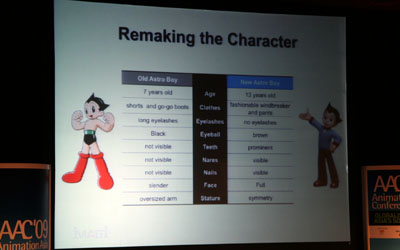
Astro Boy adapted for Hollywood sensibilities
I think the fact that Imagi is a Hong Kong company may have something to do with it too. Given that Chinese authorities have an annual quota of twenty on the number of imported foreign films, there’s a artificial lack of competition when it comes to box office sales. I wonder if Astro Boy was considered a local film and given certain preferential treatment.
Shiro Sasaki, CEO of Flying Dog (a division of Victor Entertainment), gave what I feel was the best presentation of the conference. Flying Dog manages many of the big names in anime music production, such as Yoko Kanno, Yuki Kajiura, Akino Arai, ALI PROJECT, Round Table and my all-time favourite Maaya Sakamoto. Looking at the number of titles for which Sasaki is credited as music producer (Ghost in the Shell, Akira, Cowboy Bebop, Noir to name a few), it is no exaggeration to say that he basically shaped our entire perception of what anime music is all about.
He did a presentation on Macross Frontier where music plays a particularly important role. For each Macross title, Flying Dog looks for fresh voice talents so that the audience associates the songs with the characters instead of any established singer. The talents are then developed in parallel to their fictional counterparts using various real-life promotional events that mirror those found in the anime until eventually they become established enough to release their own work. This is standard industry practice now, but Sasaki and Victor have been doing it since the original Macross.
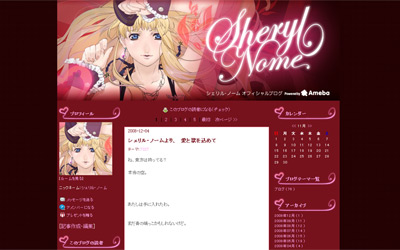
Sheryl Nome’s blog
I think the commercial success of Sheryl and Ranka in Macross Frontier points to the inevitable future of all-digital idols. When a future iteration of Hatsune Miku eventually successfully navigates its way through the uncanny valley to emerge on the side of ultra-realism, real idols will be out of work for good. Considering how precious little is real when it comes to idol marketing, it’s really the next logical step.
Danny Choo did a presentation on his Mirai Gaia ecommerce platform which is interesting as usual, but I think I had already heard most of it before.
Kotaro Sugiyama, creative czar of Dentsu Inc., presented on Dentsu Japan’s past and recent unconventional advertising campaigns, including their recent idea to build a giant Gundam in Odaiba to commemorate 30 years of Gundam and the viral Big Shadow campaign for Blue Dragon on Xbox 360. Their folllow-up plan is to build another Gundam in Paris(?!). Although most anime fans would not have heard of the advertising company Dentsu, they are actually a huge player in the industry. AFA itself was created by Dentsu’s Singapore branch.
Vince Shortino, president of Crunchyroll Kabushiki Kaisha (their operations in Japan), talked about how Crunchyroll managed to convince Japanese right-holders and turn itself from an illegal den of pirates to a fully-licensed online business model.
The Crunchyroll presentation was very thought-provoking, mainly because it mirrored my views from two years ago at the time when the Odex crackdown appeared to be a foreshadowing of a wider industry backlash against fansubbing. Unfortunately, Odex, despite its wealth of industry connections, was and continues to be stuck in the comforts of the status quo and did not have the right combination of ideas, resources and luck to take advantage of what it saw as the doom of creative media. Crunchyroll, a California-based startup with all the right experience (or lack thereof) and can-do optimism that has been the heart of the Silicon Valley’s numerous successes, managed to do just that in spite of having to start from a difficult negotiating position, given that they were perceived to be a huge source of piracy back in 2007.
I pitched this exact idea (online streaming of the latest shows paid for by a combination of subscription and advertising) to Peter Goh, the CEO of Odex, back then and was given a long lecture on how it was impossible to obtain such concessions from the Japanese studios and how I was young and naive (or something to that effect). This seems to be a problem with the mindset of a lot of local businesses — we as Singaporeans are just too used to toeing the line. It was “impossible” to get Japanese support for an online streaming service, but only because no one seriously tried it until Crunchyroll. I hope Odex learnt a lesson from this, but I doubt it.

Crunchy roll iz in ur industry, destoyin’ ur bizness model
Interestingly, there was a short discussion after Vince’s presentation and one of the invited participants was Mr. Steve Tan, a digital IP lawyer from Rajah & Tann LLP. The very same law firm that represented Odex in its aborted crusade against illegal downloaders. It doesn’t take a genius to imagine what his main points were. He started going on about how right holders can only successfully defend their properties if they band together and launch a legal “blitzkrieg” against illegal downloaders, a transparent reference to Odex’s failure due to it being perceived as acting on its own accord. Vince tactfully shot him down by pointing out that it is the advancement in technology that has made past distribution models obsolete and not any intentional evil on the part of the consumers. Forcing fans to return to less convenient means of obtaining anime through legal threats will only drive them away from anime and the only way to discourage illegal downloads is to make legal ones available. It’s a self-serving argument to be sure, but it’s a valid one.
However, I do find it somewhat ironic that Crunchyroll offers anti-piracy tools to the content owners that indexes other video-sharing sites looking for infringing materials. It makes sense from a business perspective because it gives added value to its corporate customers, but the elephant in the room is that such tools would’ve been used against Crunchyroll itself had they been made available to the studios in 2007.
Enforcement essentially prevents any new competitors from following its footsteps, giving Crunchyroll virtual monopoly over the streaming model, and I think there is some conflict of interest for Crunchyroll to take an active role in targeting infringements on competing sites. It’s not necessarily a bad thing and in the long run, should this new model prove viable, established distributors with sufficient capital can still enter the market (like how Microsoft successfully forced its way into console gaming). It’s just too late for the rest of the garage startups.
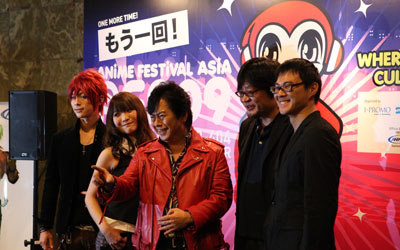
AFA preview event during the lunch break. Photo provided by Alafista
AAC was on the whole a very meaningful experience with quite a few pleasant surprises. Well, I’m off to AFA now. Hope it will continue this positive trend and outshine my humble expectations. ;)

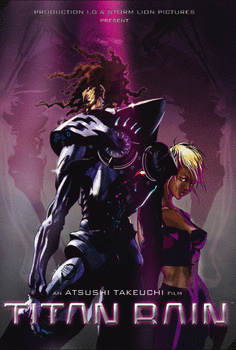
Pingback: BlogLinkJapan » Animation Asia Conference 2009
It’s too late for odex.
I’ve been with cruchyroll since It’s beginnings, and it always struck me that even though all the videos on it were fansubs, it seemed they tried to remain as legal as possible. As soon as an anime was licensed BAM all related videos were removed and in that gaping hole was left some red text saying “REMOVED”. I will admit, it always pissed me off, the straddling of the line between legal and illegal they did (or tried to do, fansubs=illegal) And i was quite angry about CR going completely legal before i thought about, mostly because the choice of anime was severely cut down (into the single digits in the beginning) and because those animes that were up were only available to residents of the U.S. or related territories. When I thought about it however, I realized that this decision to go legal was a new and interesting one, and I wished to see how it went. It seems to be flourishing now, more titles are being added to their arsenal all the time.
I’m actually going to have to partially agree with Peter Goh on why you couldn’t convince the Japanese side to do streaming, at least from his POV as a Singapore anime licensor.
CR had a lot of “being at the right place and time” moments, and from certain insiders I’ve talked to they certainly weren’t the first to try to convince the Japanese side to do streaming (I’ve heard that Funi pitched it to the Japanese even earlier). Why CR got through in the end though is basically the following points:
1) they had a large chuck of VC money to burn
2) they were an established internet site with proven traffic, hot on the heals of the Youtube and Nicodouga accqusitions (whereas the other licensors weren’t)
3) follow from above, Gonzo bought into them (the other licensors weren’t up for grabs, and they weren’t hot internet stocks, which makes them lesser of a return of investment, business investment wise)
4) they were American (yes, it matters, I’ve heard from contacts the Japanese wants to offer the Americans first dips because they are the still the largest non-Japanese anime sector, revenue wise)
It’s not a matter of the licensors didn’t try (which I know for a fact), it’s just they are in a different position to negotiate with the licensees. And if you are just pitching the whole streaming idea, than yes, I would say it is a bit naive because the devil is in the details as the idea of streaming media goes way back and the licensors, AFAIK, had all tried pitching it.
At the prices they were charging, was definitely going to give this a miss.
Sounds very interesting, with the economic downturn and decline of anime in America, it’s good to see it booming in other countries. Definitely a lot more interesting than this year’s Anime Expo industry keynotes, I pretty much skipped all of them. Time to book my tickets for AFA 2010 and bring the rest of the crew it looks like.
Pingback: Anime Festival Asia 2009 | Furu Anime Panikku
Pingback: Otakunvirka » Väliinputoajien maa
Hello People! Just wanted to tell you that I got tickets to American Idols Live event on Jul 08th. In this webpage you can find tickets for other dates too. It’s wonderful their performance on stage, this is my third time and I’m still so excited about listening those guys live! On this page you can see the section where you’re buying the ticket, so it’s very recommended! Enjoy!!